Editor’s Note: This post references Pat’s old email service provider, Aweber. We now recommend Kit instead. SPI is an affiliate and Pat Flynn is a compensated advisor for Kit, meaning that we receive affiliate revenue if you purchase through our links for Kit. The advice in this post is ESP-agnostic; that is, it will work no matter which provider you choose.
It might seem like a weird time of the year to write about autoresponder email messages, especially with everyone else talking about their goals for 2011 and what they hope to accomplish come the new year. But in my case, I feel it’s appropriate because it’s been exactly one year since I introduced my own newsletter and autoresponder series for the Smart Passive Income Blog. One year since I began building an email list.
As many of you know, at the same time I also introduced my free ebook, Ebooks the Smart Way, as a “lead magnet” (that’s what the pros call it) to hopefully entice people to sign up, and as I usually do with everything else I’ve got my hands in, I’m happy to share my results with you.
Using Aweber to handle everything, I’ve accumulated 8,252 subscribers over the past year. [Full Disclosure: As an affiliate, SPI Media receives compensation, at no additional cost to you, if you purchase through this link.] To some of you, this may seem like a lot, but for others, it might seem like nothing. There are professional internet marketers out there with lists of over 100,000 people which is very impressive.
That being said, it’s not the size of the list that matters, it’s how responsive it is. If you have a list of 100,000 people but only 5% of them open your emails, then you basically have a list of only 5000 people.
I’ve been very fortunate to have obtained a list of very responsive subscribers (Thank you! You all rock!). My open rate (the percentage of people who actually open the emails that I send out) averages around 55-60% per email. From what I’ve heard, this is much better than typical open rates, which hover around 20-30% (source: Warrior Forum).
Below, I’ll share with you 4 different examples of how you can handle your autoresponder series, including the one that I use which attributes to my very high open rates, as well as the one you should absolutely avoid.
What Is An Autoresponder Series?
Before I get into the 4 examples, I’m sure there are a few of you out there who don’t know what an autoresponder series is. If you already know, feel free to skip this section. If you don’t, keep reading.
An autoresponder series is just another fancy term for a number of automated pre-written emails that get sent to your subscribers in a sequential order. This is different than a broadcast, which is a one-time message that gets sent to all of your subscribers (or a particular segment of your subscribers that you set) at the same time.
What’s nice about setting up an autoresponder series is that you can take people through a sequence of emails (which begin on the first day a new person subscribes) without ever having to do any work, since you’ve already written the emails beforehand. Many people use an autoresponder series to take people through an e-Course.
Other uses for an autoresponder series include:
- Keeping in contact with subscribers.
- Promoting your own products.
- Promoting products as an affiliate.
- Providing more content to your subscribers.
- Re-introducing old content to your new subscribers.
- Getting input from your subscribers by asking them for feedback or help. You may have experienced something like this already if you’ve purchased anything from Amazon.com and received an email a few days after receiving your package asking for a review.
- Or a combination of any of the above.
The autoresponder series is one of the best tools for generating a passive income (even on a blog), because if setup properly, all you need to do is generate more leads and your pre-written emails will take care of the rest.
Autoresponder Series #1: The Bait and Hook
The bait and hook approach comes from writing a sequence of pre-written emails that work like this:
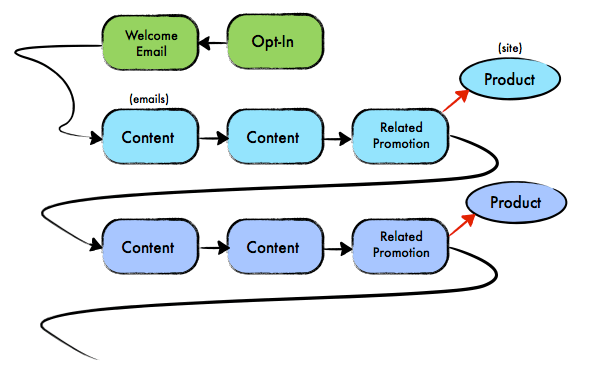
The basic premise is that valuable content related to a particular subject is provided first (the bait), and then a product or solution is introduced later (the hook).
I’m currently signed up for several different newsletters, and to me this is one of the most common methods—probably because it does work and is very powerful. While the emails with content do provide value, they also help to create awareness around a particular problem or subject matter, which the eventual product could provide a solution for.
With all that said, you do have to be cautious if you choose this method. There’s a difference between awareness and hype, and people nowadays are definitely turned off from hype-toned emails. The copy of each of the emails must be crafted carefully because it can be really easy to sound like you’re just leading up to a product, in which case the emails can be a real turn-off and you’ll find a lot of your subscribers will unsubscribe from your list.
Autoresponder Series #2: The Ground and Pound
This is the most aggressive approach to an autoresponder series, but it can still be effective and profitable in some scenarios. The ground and pound approach works like this, as you might expect:
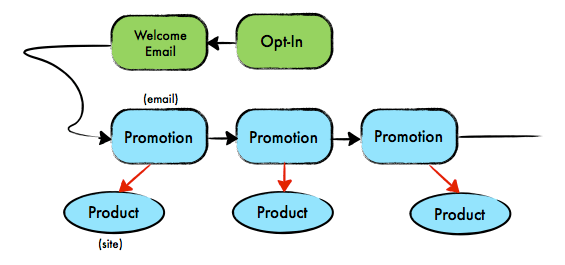
You might think that this is a big no-no, but in some situations this actually works to a website owner’s advantage.
For example, sometimes an autoresponder series is introduced to an existing customer, and these promotional/product emails are upsells for other products that compliment the initial purchase. In this case, the customer has already proven to be a buyer and so promotional emails will not be as unwelcome, and in some cases they can actually be valuable (in fact, they should always aim to be valuable).
The ground and pound sequence could also work if you properly manage the expectations of your subscribers upfront. If you blatantly tell subscribers that they will get promotional emails from you, then those who sign up will expect it—no harm, no foul.
If you had a photography site, for example, with a newsletter that sent emails with exclusive deals and tips about certain photography products and gear, then ground and pound could be your best friend.
Like I said, this only works in certain situations so you’ll have to use some common sense and think about your specific audience and their particular wants and needs.
Autoresponder Series #3: The Pat Flynn
I named this “The Pat Flynn” only because this is how I handle my autoresponder series. I’m pretty sure I’m not the first one to do this, but honestly I’m not familiar with anyone else who does, and I’m subscribed to a large number of email lists.
The Pat Flynn works like this:
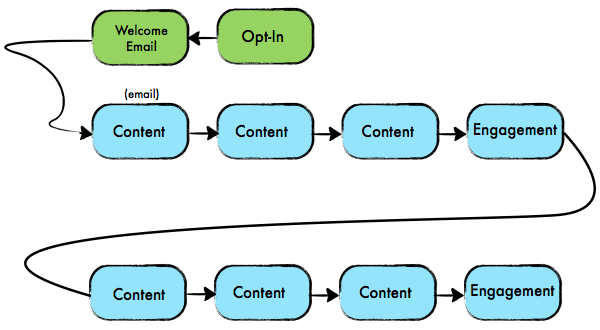
As you can see, there are two components to the Pat Flynn autoresponder series: Content and Engagement.
Content emails are tips and tricks that I provide to my subscribers that cannot be found anywhere else on the blog. This helps to keep people on my list and wanting more. Here are some responses to one of my particular autoresponder emails:
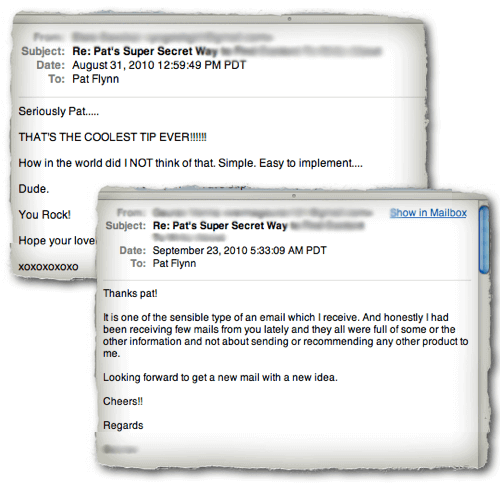
Beyond killer content, I try to engage with my subscribers. This is something I don’t see anyone else doing (I don’t know why), but I highly recommend it.
By “engage” I mean actually trying to get a response from my subscribers in a few of the emails. In one particular autoresponder email, for example, I ask my subscriber what they wish I write a blog post about. This makes people feel like they are involved with the content on my blog (which they are, because I’m in fact using a lot of the responses as inspiration for the content on my blog), and it helps them connect with me on a more personal level too. Hitting reply is a form of taking action, and any type of action taken by a subscriber is a win.
Now, you might not like this idea because “I don’t want to get a ton of emails from my subscribers.” If that’s the case, you’re going to miss out on opportunities of engagement which may not lead to an immediate click or a sale, but could help build a relationship that eventually does.
So You’ve Got Lots of Great Content And You Engage With Your Subscribers—So What?
Good question.
The real magic of my approach is two-fold:
- I’m establishing credibility and building relationships in a non-evasive manner, which keeps people on my list and opening emails. This obviously helps increase the open rate and responsiveness of my broadcast emails; and
- Some of the content emails get people back onto another platform where opportunities for affiliate sales and product sales exist.
The first point is self-explanatory—by not being aggressive and promoting anything directly on my newsletter, I have an increased open rate and responsiveness on each of my emails.
The second point is probably better illustrated by the diagram below, which is the same diagram as above, with a few more add-ons:
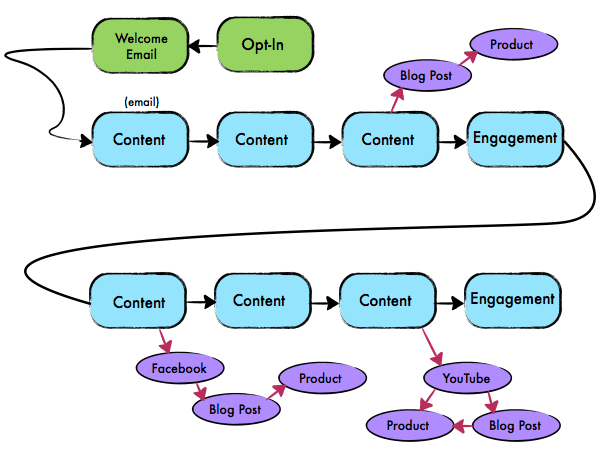
This doesn’t represent the exact order of how everything happens—I currently have over 25 pre-written emails setup in my autoresponder series and things happen at various time (I test a lot), but I think you get the main idea.
The newsletter is not where any promotion occurs, it’s used as another medium to connect with my readers. Money that is eventually made is made off of the newsletter, from people coming back to my blog where I do promote products as an affiliate, and will eventually promote products of my own as well.
The tough part about it is that any transactions that do take place are harder to track. In a traditional promotional type of email, it’s easy to tell how much money a campaigned has earned, based on the number of clicks on a link within that email and the commissions or sales earned as a result.
With the “Pat Flynn,” on the other hand, someone may become a fan on Facebook or subscribe to my YouTube channel as a result of one of my particular emails and may not perform any type of transaction that day, week, month or even year. But, some of those people may eventually find a link to a post on my Facebook Page or watch a newly uploaded Video on YouTube and be interested in something that I recommend, or a product that I release.
Maybe a person will end up on my blog as a result of one of my emails and see one of the ads in the sidebar. There are multiple points of possible transactions that can stem from the newsletter, but again I find it particularly important to use the newsletter as a relationship builder—not the point of sale.
Is this the best way to do things? It is for me, but for you it’ll depend on your niche and your audience, so think about it from your readers’ perspective and what they would want to get in your emails.
Autoresponder Series #4: The One To Avoid
Below is an email sequence that you should try to avoid. Unfortunately, this is the sequence that most people usually have:
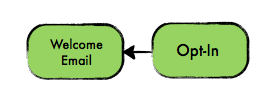
A.K.A. no autoresponder sequence at all.
A lot of people setup their email lists (use this beginner’s guide if you don’t know how) and focus purely on the broadcast emails. Broadcasts are great and should be included from time to time, however if you skip the autoresponder sequence you’re missing out on valuable, passive income opportunities.
Remember, it’s all about working hard now so you can reap the benefits later, and it really doesn’t take too much time to setup an autoresponder series.
I hope you found this post helpful, and if you’d like to get to know my autoresponder sequence first hand and get those exclusive tips and tips I was talking about, I invite you to subscribe to my newsletter (and get a free copy of Ebooks the Smart Way too!) by clicking here.
Cheers!
Any thoughts?



